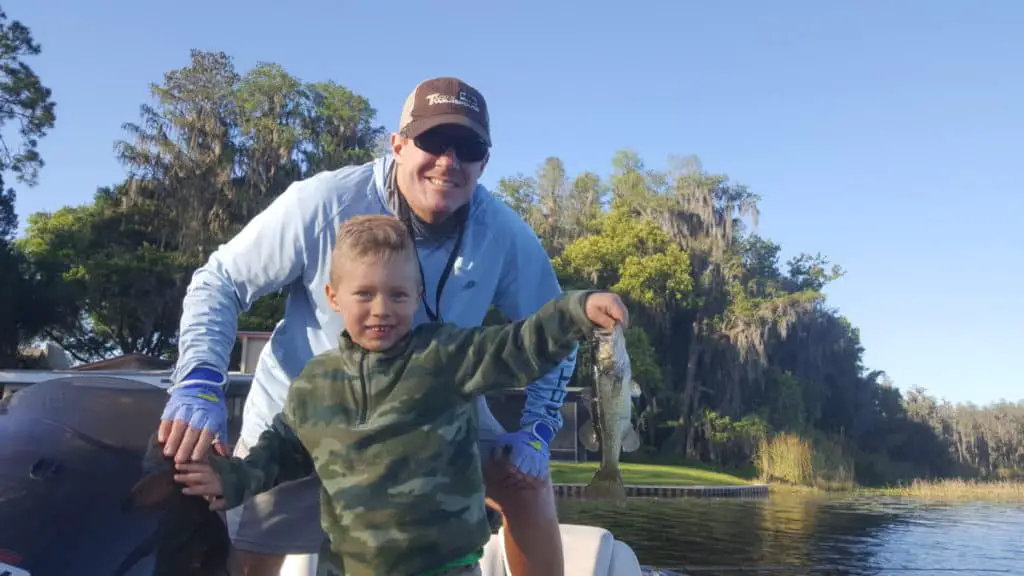
NOTHING gets the juices flowing of a bass angler, like seeing a school of bass busting the water in pursuit of bait. You can’t seem to get to the fish fast enough for an easy bite.
Schooling bass, while feeding, aren’t always so eager to latch on to artificial bait. So using the right techniques and tactics for “schoolies” is critical to increasing your catch rate. Read on for detailed information and five great tips on how to catch schooling bass.
Do Bass Swim in Schools?
Bass swim in schools throughout the year, but not all of them. Some bass establish territory where they become “resident,” singular bass. During the spawn, bass tend to move away from schooling behavior as they establish individual beds. Many post-spawn bass, once again, group into schools.
Why Do Bass School?
Bass school to feed on baitfish like shad, herring, and other minnows. They corral fish together in a concerted effort to confine them into bait balls. Bass like to push bait together to make them easier targets for meals.
When Do Bass School?
Although bass can group up throughout the year, some times deserve special attention and vigilance for schooling fish.
The fall season is well-known as a time of year when bass tend to group and feed on bait. Bait tends to head toward shallower water in creek arms in river channel-based fisheries, where you’ll also find grouped-up bass.
During late spring and summer months, bass will, once again, gang up on baitfish like shad. Any time there is a shad spawn, you’ll likely find schools of bass.
Where Do Bass School? 4 Ways to Find Schooling Bass
1. Look for Bait to Located Schooling Bass
Find the bait, and you’ll find the bass. It sounds pretty simple, but many anglers miss golden opportunities to catch schooling bass because they forget to slow down mentally and observe their surroundings. When the water is calmer, usually early in the morning before the wind has picked up, watch the water surface for “disturbed” water.
In other words, where most of the water you see looks the same, pay attention to noticeable irregularities on the surface. Watch for “flickering” balls of fish as the sun reflects off the scales of large masses of baitfish. Once you’ve located bait, bass will not be far behind.
2. Look for Birds to Identify Groups of Bass
Again, use your eyes to observe nature. For example, if you see birds diving into the water, stop what you’re doing and beeline it as quickly (and safely) as possible to the site of the diving birds. They’ve found bait from their eyes in the sky and their “dive-bombing” them to catch meals.
As mentioned above, the key to finding schools of bass often starts with finding schools of bait.
3. Use electronics to Locate Bait and Bass
Fishfinders are an amazing tool that can help you locate schools of deep water or offshore bass.
Schools of bass will usually relate to offshore structures like channel swings, points, and more. All are places where bass can set up shop to lie in wait to attack baitfish.
On your fishfinder, look for bigger “globs” of bait which usually appear in the middle of the water column on your graph because most offshore balls of bait are suspended.
Often, you can see a group of bass following the ball of bait on your electronics if you look closely enough. If you don’t see the bass but do see the bait, I would highly recommend that you still fish near that ball of bait because bass are likely close by.
Finally, use your fishfinder to look for schools of bass offshore, especially when you find COVER mixed with offshore STRUCTURE. If you find both elements together, it’s time to pause and observe the cover to determine if there are bass in a school on the cover. For example, if you find a brush pile (cover) on an offshore, underwater main lake point, carefully examine that brush pile in search of waiting groups of bass.
4. Stop and Look Around for Obvious Bass Busting
This one’s kind of obvious but is still worth mentioning. Use your EYES to observe.
Sometimes, I have to remind myself to pay attention to my surroundings because I get so myopic or ultra-focused that I forget to watch for obvious signs of schooling fish. If you see them busting on top, go to the school and start fishing!
How to Catch Schooling Bass. 5 Tricks to Get Them to Bite
1. Match the Hatch For Schooling Bass
I would say that this is probably the number one key to your success with schooling bass. First, gain an understanding of the size and color of the prevailing forage in your fishery.
Use lures that, as closely as possible, match the hatch. Your lure must resemble the target of schooling bass as much as possible.
2. Don’t Neglect Subsurface Schooling Bass
Start by fishing for bass visible to the eye (primarily ones you see on the water’s surface). If you’re not having luck there, move on to bass suspended in the middle of the water column.
If they’re not reacting to your bait on top, try lures that reach mid-depth ranges. In other words, if you’re over 20 feet of water, try working a bait that moves in 10 feet of water like a crankbait that travels that depth.
Once you’ve worked the mid ranges, choose something that will work the bottom like a Texas Rig worm. Schools can lie in wait on the bottom as they prepare for their next attack.
3. Pay Attention to What Direction the Bait Is Moving
By observing which direction the bait is swimming, you may be able to anticipate bass movement as well. If so, cast out in front of the fish to time your retrieval to meet with the baitfish (and bass).
4. Fish for Schooling Bass Even When Activity Ceases
If you notice that the bass have stopped schooling, continue to fish the area. It is highly likely that the bass are still there.
Bass school in certain parts of the lake for a reason, usually because they are relating to something in that area. Your job is to find out why the bass are there and then change tactics to fish whatever structure or cover is causing the bass to be there.
Do this, and you’ll continue to catch bass in schools even after outward signs of schooling are over.
5. Stop Casting So Much and Wait for Schooling Bass to Show Themselves
WAIT to cast. Waiting to cast until you see the next evidence of schoolers is extremely important. Scenario: you see schooling bass, but the “busting” has stopped. You continue to cast in the area because you just know that the bass are still there. I am 100 percent guilty of this fishing sin.
The key to being ready to catch schooling bass is to sit and wait patiently for bass to show themselves. If you’re mid-cast when you notice a new group of bass come to the surface to eat, you’ll be too late to reach them if you have to take the time to reel in your current cast.
A better tactic is to wait (albeit painfully) until you clearly see schooling bass come to the surface and THEN make your cast at the school. Waiting to cast will dramatically increase your catch rates for schooling bass.
13 of the Best Lures and Baits For Schooling Bass
Using the right presentation will go a long way to help you hook up with schooling bass. Check out 13 of the best lures and baits for schooling bass.
1. Catch Bass in Schools With a Fluke
I like to fish with flukes a couple of different ways for grouped-up bass.
Use a fluke that matches the color of the prevailing baitfish. Try fishing it subsurface by adding a very small bullet head weight. Let it sink just below the surface and twitch it with a pause between each movement to resemble a dying baitfish.
My favorite way to use a fluke for schooling fish is to “burn” it on top while twitching it to “skim” it across the water’s surface, so it resembles a fleeing baitfish.
2. Topwater for Schooling Bass
Try working a popper or floating jerkbait with a quick tempo to elicit a reaction strike from schooling bass. Once again, try to match the size of your lure to the size of the bait that bass are after.
3. Small Swimbaits Work Well to Catch Bass in Schools
Small swimbaits reeled through a school of fish work wonders as a moving bait. Now and then, “kill” the bait by pausing your reeling for a half second. Bass sense that something is wrong with your bait and will attack it as weak prey.
4. Wacky Rigs for an Unconventional Approach
Many of you may be staring at the screen with a blank look right now, wondering what a wacky rig has to do with catching schooling fish.
While I admit that it’s a little out of the box, I happened upon this once after trying everything to catch schooling bass with no results.
We live on a small chain of lakes here in Florida, and I noticed schooling fish one day as I stared out of my back window. Off I went. I jumped in the boat and went to work on the school to no avail. Nothing I tried worked.
I grabbed my spinning rod and reel in frustration, threw out the wacky rig, and began working it in rather quickly by using a combination of reeling and simultaneous twitching.
What happened next was awesome. Fish after fish after fish — in the boat! The bass found the rig irresistible. I believe that the bass identified the soft plastic worm as a fluttering, dying baitfish. It worked wonders.
5. Alabama Rigs Are a Powerful Option for Schoolers
Alabama rigs, A.K.A. “A-rigs,” are one of the most incredible lures on the market. They’re so effective that they are outlawed in most major tournament trails.
If you’re a recreational fisherman or in a tournament circuit that allows them, you should always have one tied on.
For schooling bass, especially ones feeding on smaller baitfish, A-rigs should be one of the first lures you grab because they present a life-like representation of a small group of baitfish, exactly what bass are looking for.
6. Lipless Crankbaits Are Highly Effective
Lipless crankbaits are a great tool to have onboard for fishing for schools of bass. They’re easy to cast a very long distance making it a great way to reach bass that you spot busting on the surface.
Bass are attracted to the lure’s tight wobble and rattling sound that these baitfish imitators put off.
Lipless crankbaits are treble hook lures that make hookups easier and catch rates higher.
7. For Deepwater Schoolers, Try Walking baits
Walking baits serve a specific purpose. They are designed to “call up” bass from deeper water. Walking bass mimic injured baitfish making their way across the water’s surface. Bass see the lure as a chance for an easy meal causing them to bite.
8. Try Spinnerbait for Groups of Bass
Spinnerbaits come with attached blades that flash in the water during retrieval. Those flashes resemble flickering baitfish and can attract bass from a long distance. Spinnerbaits are a great option when Alabama rigs aren’t allowed, or you need a smaller profile bait imitation.
9. Jerkbaits Are Great for Bass in Groups
Fishing for schooling bass with a jerkbait is a tactic that consistently produces fish. Jerkbaits excel at catching bass suspended in the water column at mid-depth regions or near the bottom. Once again, jerkbaits are purposefully designed and fished, so they appear to be dying baitfish.
10. Floating Worms. Out of the Box
Using a floating worm for schooling bass is a bit “out of the box.”
Schooling bass are not grouped up to chase worms. So try this play when you have difficulty getting bass to bite on the usual schooling bass offerings. I’ve tried it from time and time, and it DOES produce fish.
11. Flutter Spoons. A Time Tested Lure.
Flutter spoons have long been used to work a group of bass hunkered down near the bottom. Cast it out, let it drop, then rip it up towards the surface only to let it fall again.
Most bites will come on the fall as bass perceive prey struggling for survival, thus making it an easy meal.
12. Mico Lures on Ultralight Setups for a Different Tactic
Sometimes, you’ll notice that the target prey is just too small for your normal schooling bass lures. Jerkbaits, flukes, spoons, and other lures are much bigger than the bait that bass are chasing in your lake.
In this case, don’t be afraid to pick up an ultralight fishing rod and reel and tie on something smaller that matches the size of the bait that the bass are chasing. Micro crankbaits, rooster tails, and even the good old beetle spin may work wonders on schoolies chasing smaller minnows.
For a great read on bass fishing with ultralight gear, check out Bass Fishing Insider’s article, Bass Fishing with Ultralight Gear. (Are You Missing Out?).
13. Tie On a Swimbait for Big Schools of Bass
Last but certainly not least, swimbaits are excellent lures for schooling bass. Many swimbaits are so life-like that you can barely distinguish between natural baitfish and the lure. Choose a color and size that closely resembles your lake’s forage for the best results.
Swimbaits are also great for schooling bass because they can be cast a country mile to reach fish you’ve spotted busting water on top.
The Bass Line. Final word
Locating schooling bass is only half of the battle. To catch them takes skill, effort, the right presentation, and patience. Use the information above to put the puzzle pieces together to catch schooling bass, and you’ll experience a fishing experience like no other.
Grab a rod and get to the lake!
Fish on!




